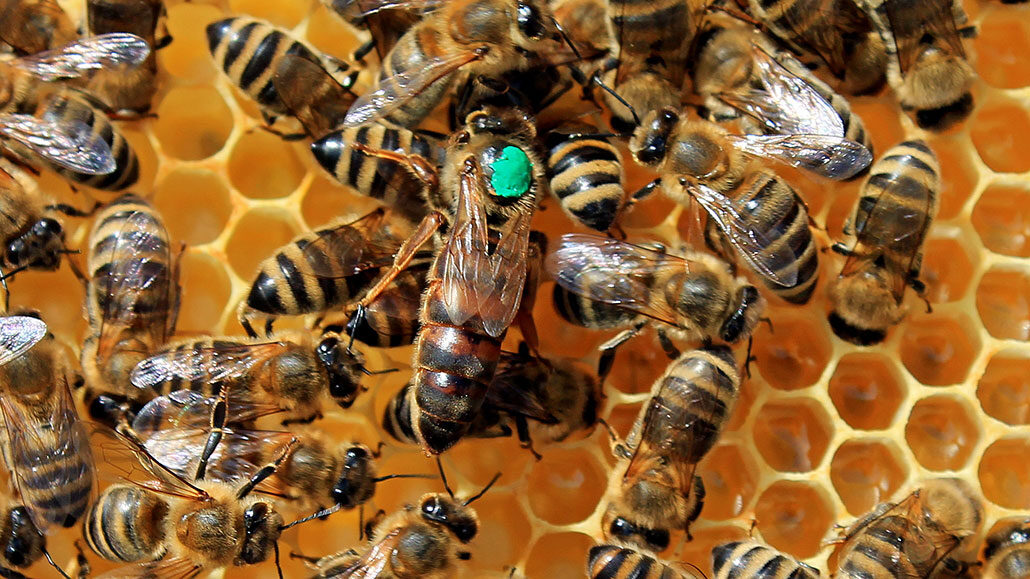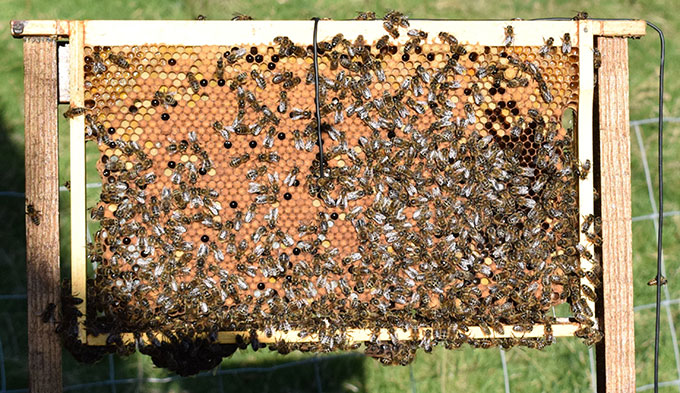Quacks and toots help young honeybee queens avoid deadly duels
The sounds alert workers on how to pace the hatching of queens

A honeybee queen surrounded by her workers. Beekeepers will sometimes mark the queen with a dot (blue-green here) to make her easier to see.
Tatrano/iStock/Getty Images Plus
You probably know honey bees buzz. The queens also quack and toot. Beekeepers have long known about these strange sounds, but not why bees made them. Now researchers think the sounds stop queens from fighting to the death.
Martin Bencsik is an expert in vibrations. He studies bees, insects that communicate through vibrations. Our ear drums register vibrations — acoustic waves — moving through the air as sound. Bees lack ear drums to hear sounds, he explains. But their bodies can still feel the difference in quacking and tooting vibrations.
Bencsik led a team at Nottingham Trent University in England that explored these bee sounds. The researchers placed vibration detectors in 25 honeybee hives. These hives were part of three different apiaries (AY-pee-air-ees) — collections of human-made beehives. One was in England, two were in France. Each beehive has a series of flat wooden frames inside a wooden box. Inside these frames, the bees make wax honeycombs. The frames slide out so that beekeepers can collect the honey.
The researchers pressed vibration detectors into the beeswax of one frame from each hive. Each acoustic detector had a long cord. It attached to a device that recorded the vibrations.
After sliding the frames back into place, the researchers settled in to watch what happened as bees tooted and how it differed from when bees quacked.

Born to rule
A honeybee colony has just one queen and many, many workers. The queen is the mother of all the bees in that hive. Workers take care of her eggs. Most of those eggs will hatch into more workers. But some will become new queens.
New queens make quacking vibrations when they are ready to hatch. That had been known from earlier studies. Then they start chewing their way out of the waxy cells in which they have been growing. Once a new queen emerges, she stops quacking and starts tooting.
Royal Vibes
Audio: M. Bencsik
Bencsik and his team believe tooting is a queen’s way of informing worker bees that she’s hatched. They also believe she’s signaling the workers not to let the other quacking queens out of their cells. That’s important because when more than one queen hatches at the same time, they will try to sting each other to death.
A thorax is the part of an insect’s body between its neck and abdomen. “When she’s ready to deliver the [tooting] signal, the queen hangs onto a honeycomb with her six legs, presses her thorax against it and vibrates it with her body,” explains Bencsik.
The workers feel the tooting vibration and move to keep the other queens captive. They do this by repairing the wax caps on the queens’ cells in the honeycomb.
Bencsik and his team didn’t see this happening because they were tracking the bees from outside the hive. But other studies in which researchers peered into hives made of glass show that this is how worker bees keep queens in their waxy prisons.
A hatched queen might wander around the hive tooting for several days. All the while, the other captive queens keep up their quacking and attempts to escape.
Starting over again
Eventually, the hatched queen flies off with about half the worker bees to start a new colony.
Watching from outside the hive, Bencsik and his team noted that this is when her tooting stops. After about four toot-free hours, the researchers began hearing a tooting begin again. This told them that a new queen had chewed her way out, and the process was starting over.
The absence of tooting is the trigger for the workers to let a new queen hatch, Bencsik concludes. “People used to think the quacking and tooting queens were sizing each other up to avoid an unnecessary fight to the death,” he says.
His team shared its new findings June 16 in the journal Scientific Reports.
A hive’s queen lays a lot of eggs. In summer, some 2,000 new worker bees hatch each day. That means there are generally enough workers for three to four queens to each lead off a swarm of workers and create new colonies.
At some point though, there will be too few workers to form another colony. When that happens, the workers let all the queens emerge at once, notes Gard Otis. He is an expert on honeybee biology in Ontario, Canada at the University of Guelph. It’s not clear how the workers know to do this, he says.
“Somehow the workers sense they can’t create another swarm and they quit rebuilding the queen cells,” Otis says. He was not involved in the study but did review it before it was published.
These last few queens will now sting each other until only one remains. The last queen standing will stick around to rule the hive. Concludes Otis, “It’s an amazing process and it’s really quite complicated.”







